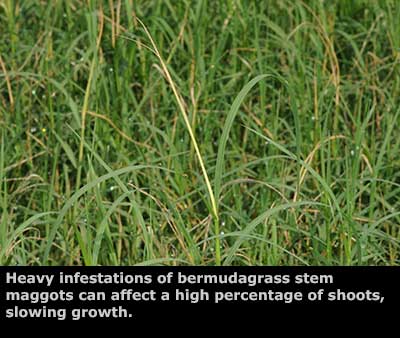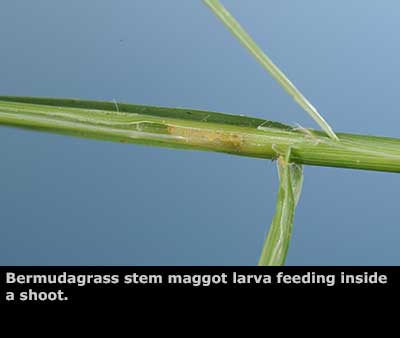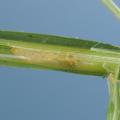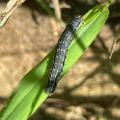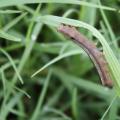Bermudagrass Stem Maggot
Bermudagrass Stem Maggot (BGSM), Antherigona reversura, is a new, non-native pest of bermudagrass hayfields that was first found in Georgia in 2010. It was first detected in Mississippi in mid-summer of 2012, and by the end of the growing season had spread to hayfields throughout the state.
Bermudagrass hay producers need to become familiar with this new pest because it has the potential to cause significant reductions in hay yields. Adult flies are about the size of horn flies and have yellow abdomens. The legless white larvae bore inside the tips of bermudagrass shoots, feeding down to the first internode and killing the shoot tip and emerging leaves. At first this may seem like relatively minor damage, but heavy infestations can essentially stop a field from growing. When viewed from a distance, heavily infested fields have an unusual bronzed appearance due to the large number of dead infested shoot tips. Such infestations have occurred across the Southeast and yield reductions have been estimated to range from 20 to 50%. Fine-stemmed bermudagrass varieties, like most of those we currently grow, are most susceptible to attack, as are highly managed, well-fertilized fields.
Populations increase through the growing season, so if the previous cutting sustained significant injury, growers should assume damage will be even higher in the next cutting—unless they treat the field. Pastures are not seriously affected because grazing continually removes susceptible shoots. The same is true for the turf-type bermudas grown in lawns, sports fields and golf courses. The flies will attack them, but frequent mowing prevents serious damage. BGSM is specific to bermudagrass and does not attack other types of grasses.
We are still learning about this pest and how to best deal with it. With currently available insecticides, the larvae cannot be controlled once they have bored into the stem. Management depends on controlling adult flies before they lay eggs. Once a field has sustained heavy damage with a high percent of shoots infested the best course of action is to harvest the field and prepare to control the flies in the next cutting. Because stem maggot populations are usually low in the spring and increase as the growing season progresses, infestations in the earlier cuttings of hay may not be high enough to cause significant damage, but the risk of damage increases for each successive cutting.
Current management recommendations for BGSM, based largely on research conducted in Georgia, are summarized below:
Base treatment decisions on the amount of damage sustained in the previous cutting. If a field had 15 to 20% or more damaged shoot tips in the previous cutting, plan on treating for BGSM in the next cutting as described below.
- Harvest the field and remove the bales
- spray 5 to 7 days after harvest (as soon as the field begins to green up again)
- use the low rate of one of the pyrethroid insecticides that is labeled for fall armyworms
- spray again 5 to 7 days later
- may wish to add 2 fl oz Dimilin 2L to 2nd spray if fall armyworms are a threat
- cut as soon as maturity and weather allow
Unfortunately, the timing required for control of BGSM does not coincide with the time in the growth cycle when fall armyworms are most likely to require control. Pyrethroid insecticides are effective against both pests, but BGSM sprays have to be applied early in the growth cycle, while fall armyworm infestations are most likely to occur in the later weeks of a crop growth cycle. Do not assume sprays applied to control BGSM will provide season-long protection against fall armyworms. Continue to scout fields regularly for fall armyworms and treat promptly when infestations occur.
Treatments for Control of Bermudagrass Stem Maggots *
| Insecticide formulation (active ingredient) |
Rate of formulated Product per acre |
No. of Acres 1 gallon of product will treat |
Pre Grazing Interval | Pre Harvest Interval (wait to cut hay) |
| Mustang Max 0.8 EC (zeta cypermethrin) |
2.8 fl oz. | 45 | 0 days | 0 |
| Baythroid XL, 1 lb/gal. (cyfluthrin) |
1.6 fl oz. | 80 | 0 days | 0 |
| Karate Z, 2.08 lb/gal. (lambda cyhalothrin) |
1.28 fl oz | 100 | 0 days | 7 days |
* This information is for preliminary planning purposes only. Generic products containing some of the active ingredients listed above are also available. Be sure to carefully read the label of any product you plan to use and follow all label restrictions carefully.
See Bug-Wise Newsletter No. 5 of 2013, Bermudagrass Stem Maggot, for additional information about BGSM.
Publications
News
Following last year’s significant fall armyworm outbreak, hay producers should be careful not to overlook another important pest -- the Bermudagrass stem maggot -- while watching for armyworms. While farm armyworms attack hay fields, home lawns, golf courses and more, the non-native Bermudagrass stem maggot is primarily a pest of hay fields.
Lawns, pastures and even winter food plots are at risk as an insect army advances across much of the state in higher than normal numbers. Blake Layton, entomologist with the Mississippi State University Extension Service, said fall armyworms are the most damaging insect pests of bermudagrass hayfields and pastures
Every year, lawns and pastures become targets for late-summer grass-eating caterpillars, making it important to watch for the usual suspects and some culprits that are less common.


